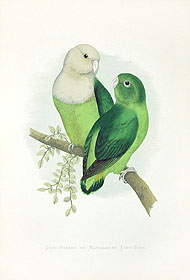|
| Query: Canary | Result: 361st of 381 | |
Grey-headed Lovebird (Agapornis cana) - Wiki
| Subject: | Grey-headed Lovebird (Agapornis cana) - Wiki
| |

| Resolution: 190x280
File Size: 15771 Bytes
Upload Date: 2007:08:10 14:24:49
|
Grey-headed Lovebird
From Wikipedia, the free encyclopedia
[Photo] English: Grey-headed Lovebird. ???Norsk (bokm??l)???: Madagaskardvergpapegøye. Author Alexander Francis Lydon (1836-1917)
The Grey-headed Lovebird or Madagascar Lovebird (Agapornis cana) is a species of parrot. This sexually dimorphic lovebird species is rarely seen in aviculture and is known to be difficult to breed. They come from the island of Madagascar off the coast of Africa and are the smallest of the lovebird species. Madagascar Lovebirds are the only lovebird species which does not originate on the African continent. Madagascar lovebirds come, not surprisingly, from the island of Madagascar, which lies off of Africa's Southeast coast.
Maddies are the smallest species of lovebird, typically weighing in at only 30-36 grams. They are delicate and nervous, and in some ways they seem more like finches than hookbills. Their beaks are small, even in relation to their body size, and they prefer finch and canary seed over the sunflower/safflower mixes that most other lovebirds relish.
Madagascars are strong fliers, and when open, their wings seem larger in relation to their bodies than those of the Peachie. Maddies can develop good speed quite quickly and effortlessly, and turn smoothly, though they are not as nimble in the air as the Peachies. I have not, for example, seen a Madagascar Lovebird hover in one place, as the Peachfaced often will.
Maddies are one of the few species of Lovebird that are sexually dimorphic. Hens are entirely green and black, with dark green on the back and wings, bright green rump and paler green breast. The flights are dark green on the leading edge, fading to black on the trailing edge. The males are similarly colored, except that their entire head and upper breast are a soft pale grey. For this reason, maddies are sometimes referred to by the name "grey-headed lovebird".
Maddies are quite rare in captivity, with only a very few breeders having successfully reproduced more than one or two generations. This, and the fact that even hand-fed birds remain too shy and nervous to make good pets, are clear reasons for any captive Madagascars to be given a chance to breed, rather than being kept as pets. Though the future of this species in captivity seems hopeful, the breeding successes and failures of the next few years may very well decide the fate of these birds for future generations of aviculturists.
Retrieved from "http://en.wikipedia.org/wiki/Grey-headed_Lovebird"
| The text in this page is based on the copyrighted Wikipedia article shown in above URL. It is used under the GNU Free Documentation License. You may redistribute it, verbatim or modified, providing that you comply with the terms of the GFDL. |
|
Comments |
|---|
| | Guest |
|
| Hello! Good Site! Thanks you! xokwgkskrr |
^o^
Animal Pictures Archive for smart phones
^o^
|
|
|